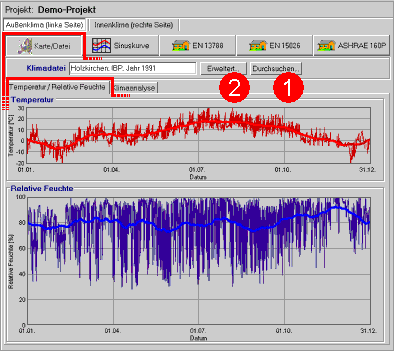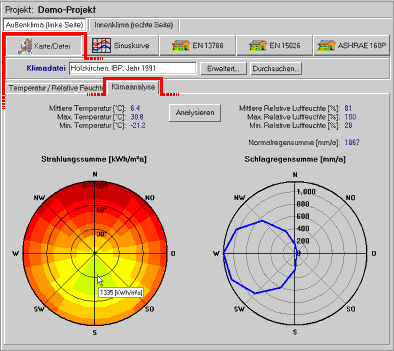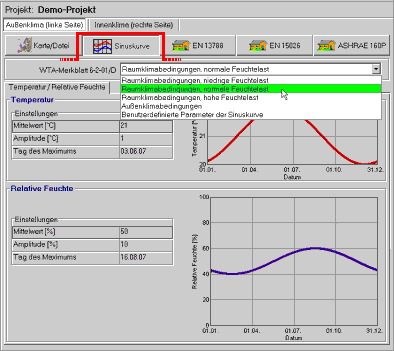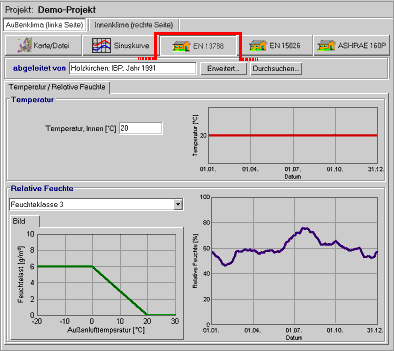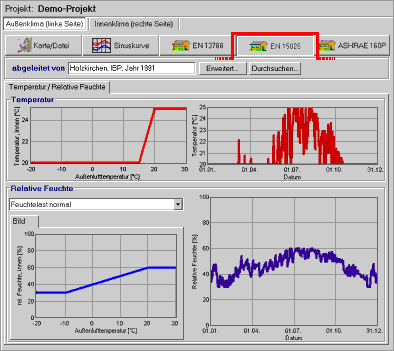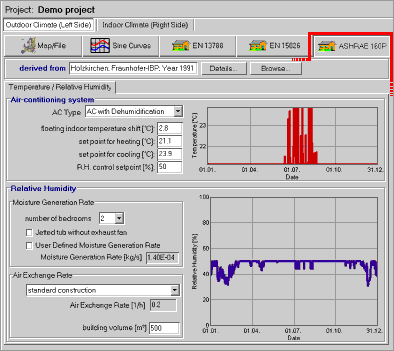2D:Dialog SelectClimate
Dialog: Select Climate
At its surfaces the building component is exposed to the climatic boundary conditions which have a profound effect on its hygrothermic behaviour. As discussed in the topic Climate data, WUFI needs for each time step and for each of the surfaces data on the rain and radiation load acting upon the surface and on the temperature and relative humidity of the adjacent air.
A two-dimensional building component usually has several different surfaces which may be exposed to different climatic conditions. Each of the surfaces must be assigned its respective boundary conditions. The boundary conditions may be given as hourly data read from a climate file or as interior conditions derived from a climate file or as schematic yearly sine curves.
"Map/File":
Choose this option if the boundary conditions are to be read from
a climate file.
The button "Browse..." (1) opens a dialog
in which you can select the desired climate file
on a map or through a
file open dialog.
The button "Details..." (2) opens a subdialog
which offers additional options, depending
on the climate file format (e.g. to use measured
surface or ground temperatures etc.).
Once you have selected a climate file, WUFI will plot the temperature and the relative humidity. The thin curves show the data read from the climate file, the bold curves represent the centered moving monthly means for easier visual accessibility. You may also have a climate analysis performed.
Click on the button "Analyze" to start the analysis. WUFI will display the
minimum, maximum and mean values of temperature and relative humidity, the normal
(i.e. vertical) rain sum and the directional distributions of solar radiation
and driving rain:
The radiation rose shows the yearly sum of global radiation for receiving surfaces
with different orientations and inclinations, the driving rain rose shows the
yearly sum of driving rain on free-standing vertical surfaces
( R2 = 0.2 s/m) with different orientations.
These data will give you an overview of the most important characteristics of the selected year. In particular, the radiation and rain roses show the directions from which the radiation and rain loads on the facade are mainly to be expected.
*.KLI files can not be analyzed,
since their radiation and rain data have already been converted for a fixed
orientation and inclination.
The analysis of *.WET files is
independent of any options you may have selected in the
"Details..." subdialog; that is, the
temperature analysis always reads the air temperature from the file, the radiation
analysis always reads the global and diffuse radiation on a horizontal surface
and the driving rain analysis always reads the normal rain and the wind speed
and direction.
If the boundary conditions assigned to a surface are being read from a climate file of *.WET, *.TRY, *.DAT, *.IWC, *.WAC or *.WBC type, you also need to specify the orientation and inclination of the facade so that WUFI can convert rain and solar radiation for that direction. If you use a *.KLI file, it is assumed that rain and radiation have already been converted for the proper orientation and inclination.
"Sine Curves":
In some cases it is sufficient to ignore short-term fluctuations of the boundary
conditions and to consider only their long-term (e.g. yearly) trend (this is only
possible if the highly variable quantities rain and solar radiation play no role
anyway). Temperature and relative humidity may then be modelled by simple
sine curves with yearly period, or even by constant values.
These conditions are usually met by the interior climate: the daily
variations of indoor temperature and humidity are strongly damped by the heat and
sorption capacities of the furnishings; the remaining fluctuations do not
penetrate far into the building components and only have a negligible effect
on their hygrothermal behaviour. If the component is not affected by rain
and solar radiation, and if its hygrothermal inertia is large enough, even
the exterior climate may be modeled in this simplified way.
WUFI generates the temperature as a sine wave with one-year period from
the yearly mean value, the amplitude and the
day of maximum specified by the user.
The default values suggested for indoor conditions (mean temperature: 20°C,
amplitude: 1°C) correspond to typical temperatures in residential homes,
as determined by measurements [1].
The default values suggested for exterior conditions (mean temperature: 9°C,
amplitude: 9°C) correspond to typical conditions in Germany [1].
WUFI generates the relative humidity as a sine wave with one-year period
from the yearly mean value, the amplitude and the
day of maximum specified by the user.
The default values suggested for indoor conditions correspond to the average
humidities in residential homes under low, normal and high moisture load [1].
The moisture load is the difference between the water vapor concentrations
of the indoor and the outdoor air. It depends on the indoor moisture production
and the air change rate.
The default values suggested for exterior conditions (mean value: 80%, amplitude: 8%) correspond to typical conditions in Germany [1].
If you wish to use other values than the defaults, choose "User-Defined Sine Curve Parameters" from the drop-down list and enter your values in the text boxes which can now be edited. If you want to simply use constant values, you may hide the text boxes for amplitude and day of maximum by checking the option "constant".
Literature:
| [1] | WTA Guideline 6-2-01/E: Simulation of Heat and Moisture Transfer. |
"EN 13788":
With this option you can derive an interior climate from an exterior climate, using the algorithm specified by DIN EN ISO 13788. Use the "Browse..." button to select the climate file which shall provide the source data.
For the relative humidity, you may select one of four predefined humidity classes from the drop-down list. You may also specify your own moisture load function by selecting "User-defined" from the drop-down list: there appears a table where you can enter your values for the function.
Method of calculation:
The relative humidity for the interior climate is determined from the interior air temperature (held fixed) and the absolute humidity Ni of the interior air. For Ni, we have:
Ni = Na + dN Ni:interior absolute humidity, Na:exterior absolute humidity dN:moisture supplement, determined from q a by means of the moisture load function Na.
Na = j a
- absolute-humidity-at-saturation(q a)
q a:monthly centered moving mean of exterior air temperature j a:monthly centered moving mean of exterior relative humidity
"prEN 15026":
With this option you can derive an interior climate from an exterior climate, using the algorithm specified by prEN 15026. Use the "Browse..." button to select the climate file which shall provide the source data.
The interior air temperature is determined from the exterior air temperature by means of a transfer function; the interior relative humidity is also determined from the exterior air temperature by means of a transfer function:
q i = temperature-function(q a), j i = humidity-function(q&bnsp;a).
q i:interior air temperature, j i:interior relative humidity, q a:daily centered moving mean of the exterior air temperature.
For the relative humidity, you may select one of two predefined moisture loads from the drop-down list ("normal" and "high").
If the prEN 15026 option is used, no orientation and inclination needs to be specified, since it is then assumed that there is neither rain nor solar radiation acting on this surface.
"ASHRAE 160P"
With this option you can derive the interior climate from the exterior climate, using the algorithm specified by ASHRAE Standard 160P.
For details please refer to: ASHRAE Standard 160P, "Design Criteria for Moisture Control in Buildings" (Draft July 2006). WUFI determines the indoor climate by the method illustrated in "Flowchart 3. Indoor design humidity, intermediate method".
